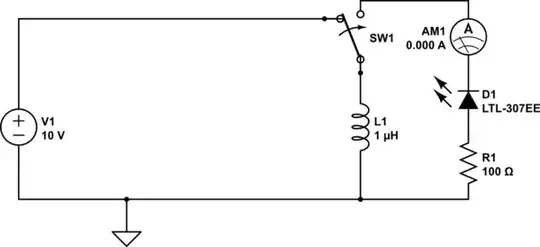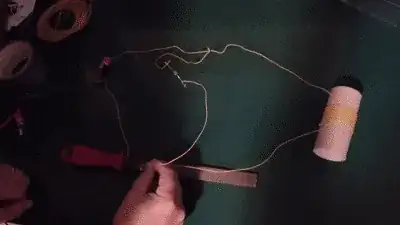I just want to know if an air coil can store energy. Does it necessarily need to have a core material and air gap to store energy?
-
Coils in RF desn’t have ferrous core but of course they store energy. – Michal Podmanický Feb 03 '24 at 14:12
-
The question is always: over what time scale? Microseconds, certainly; milliseconds, with difficulty; hours, get a battery; eons, make hydrocarbons! :) – Tim Williams Feb 03 '24 at 14:15
4 Answers
Any coil will store energy, whether it has an air core or some other material.
This is an air core coil I made a few years ago to show how boost converters work:
Scratching the wire along the file causes a pulsing current to flow through the inductor. When current flows through the coil, energy is stored. When the current stops, the coil sheds its stored energy through the LED by pushing the voltage up high enough that the LED conducts.
For that simple circuit to work, the coil has to store energy. Since the coil has an air core and widely spaced windings, the inductance is very low (approximately 30 microhenries.) It doesn't store much energy, but that's fine - if it stored more energy it would probably damage the LED.
This is the circuit from the "simple voltage booster" project:
The LED is connected such that it cannot be lit from the 1.5V cell - it is connected in reverse polarity with respect to the cell. The LED can only be lit by the discharging energy from the coil.
- 71,321
- 10
- 107
- 188
I just want to know if an air coil can store energy. Does it necessarily need to have a core material and air gap to store energy?
The energy stored in an (ideal) inductor is
$$\mathscr{E}=\frac{I^2L}{2}$$
An air core inductor will have less inductance than a similarly sized inductor with solid core. However, two (ideal) inductors with the same inductance will store the same energy when they have the same current passing through them, assuming the cores are ideal and not saturated.
- 23,260
- 4
- 21
- 75
Any inductor will store energy, including air-core ones.
If we disregard superconducting windings, which have their own set of material-specific tradeoffs, then we wind with copper. It's about as good as it gets for wire, silver has a slightly higher conductivity, but we don't use it because of the cost.
For the standard shapes that 'good' inductors have, the resistivity that copper happens to have, and the permeability that air happens to have, we can store most energy per weight for the longest time in an inductor with a core with a relative permeability (μr) in the 10 to 20 range. Any other μr will still store energy, just less efficiently. Yes, that means plain 'transformer iron' with a μr of thousands is really bad at storing energy, it's far too heavy for the amount it stores.
There are no single-component materials with this sort of permeability, but we can make them from several components.
- One way is to use a magnetic core that's mostly transformer iron, but with an air-gap breaking the circuit. Interestingly, almost all the energy is stored in the gap, and very little in the iron. The gap often isn't air, but something non-magnetic like a plastic or paper shim.
- Another way is to distribute this gap by putting iron or ferrite powder into a non-magnetic matrix, like epoxy. It can be quite difficult just by looking at a random core to know whether it's a low μr 'energy storage' core, for instance for flybacks, SMPS and inductors, or a high μr 'transformer' core for transformers.
- 166,079
- 3
- 185
- 408
Yes, you can test it yourself using this simple circuit:

simulate this circuit – Schematic created using CircuitLab
The diode will flash when the switch is closed and thus the circuit disconnected from the battery. The energy in the inductor is discharged through the diode. Note that the polarity of the discharging current is inverse to the polarity it was charged with.

